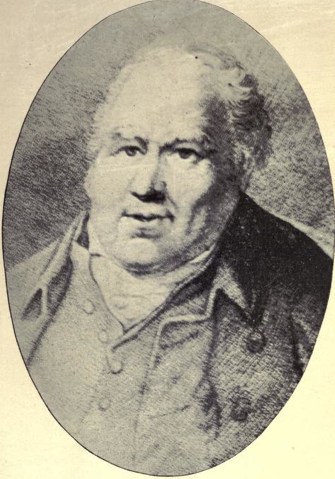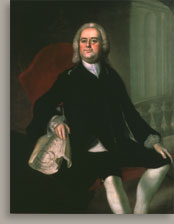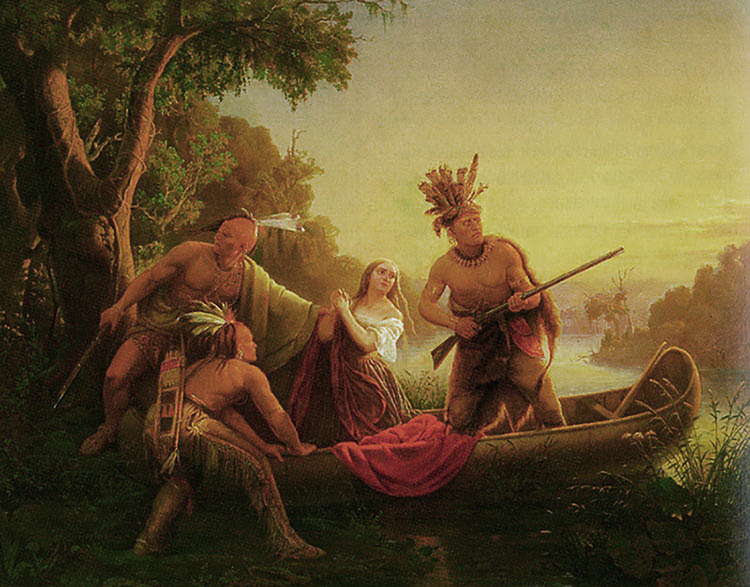|
Michael Francklin
Michael Francklin or Franklin (6 December 1733 – 8 November 1782) served as Nova Scotia's Lieutenant Governor from 1766 to 1772. He is buried in the crypt of St. Paul's Church (Halifax). Early life and immigration Born in Poole, England, Francklin immigrated to Halifax, Nova Scotia in 1752. He worked as a trader and merchant, initially in association with Joshua Maugher. Capture During Father Le Loutre's War, Michael Francklin was captured by a Mi'kmaw raiding party in 1754 and held captive for three months in which he learned the Mi'kmaw language and developed an appreciation for native culture. Political career Francklin represented Lunenburg County from 1759 to 1760 and Halifax County from 1761 to 1762 in the Nova Scotia House of Assembly. On February 7, 1762, Francklin married Susannah Boutineau. In May of that year, he was named to the Nova Scotia Council. In the early 1770s, he was responsible for bringing about the Yorkshire Emigration. He also played an imp ... [...More Info...] [...Related Items...] OR: [Wikipedia] [Google] [Baidu] |
Franklin Manor 22
Franklin Manor 22 is a Mi'kmaq reserve located in Cumberland County, Nova Scotia. It is administratively split between the Pictou Landing First Nation and the Paq'tnkek First Nation. The community is named after Nova Scotia Governor Michael Francklin Michael Francklin or Franklin (6 December 1733 – 8 November 1782) served as Nova Scotia's Lieutenant Governor from 1766 to 1772. He is buried in the crypt of St. Paul's Church (Halifax). Early life and immigration Born in Poole, England, ..., who spoke Mi'kmaq and whose funeral was attended by hundreds of Mi'kmaq. Franklin Manor, Champs-Élysées, Maccan, and Nappan are villages where the Acadians lived post deportation, in Cumberland County, Nova Scotia, not far from the Beaubassin / Ft. Beausejour area. References Indian reserves in Nova Scotia Communities in Cumberland County, Nova Scotia Mi'kmaq in Canada {{NovaScotia-geo-stub ... [...More Info...] [...Related Items...] OR: [Wikipedia] [Google] [Baidu] |
Governors Of The Colony Of Nova Scotia
A governor is an administrative leader and head of a polity or political region, ranking under the head of state and in some cases, such as governors-general, as the head of state's official representative. Depending on the type of political region or polity, a ''governor'' may be either appointed or elected, and the governor's powers can vary significantly, depending on the public laws in place locally. The adjective pertaining to a governor is gubernatorial, from the Latin root ''gubernare''. Ancient empires Pre-Roman empires Though the legal and administrative framework of provinces, each administrated by a governor, was created by the Romans, the term ''governor'' has been a convenient term for historians to describe similar systems in antiquity. Indeed, many regions of the pre-Roman antiquity were ultimately replaced by Roman 'standardized' provincial governments after their conquest by Rome. Plato used the metaphor of turning the Ship of State with a rudder; the Latin ... [...More Info...] [...Related Items...] OR: [Wikipedia] [Google] [Baidu] |
1782 Deaths
Year 178 ( CLXXVIII) was a common year starting on Wednesday (link will display the full calendar) of the Julian calendar. At the time, it was known as the Year of the Consulship of Scipio and Rufus (or, less frequently, year 931 ''Ab urbe condita''). The denomination 178 for this year has been used since the early medieval period, when the Anno Domini calendar era became the prevalent method in Europe for naming years. Events By place Roman Empire * Bruttia Crispina marries Commodus, and receives the title of '' Augusta''. * Emperor Marcus Aurelius and his son Commodus arrive at Carnuntum in Pannonia, and travel to the Danube to fight against the Marcomanni. Asia * Last (7th) year of ''Xiping'' era and start of ''Guanghe'' era of the Chinese Han Dynasty. * In India, the decline of the Kushan Empire begins. The Sassanides take over Central Asia. Religion * The Montanist heresy is condemned for the first time. Births * Lü Meng, Chinese general (d. 220) * P ... [...More Info...] [...Related Items...] OR: [Wikipedia] [Google] [Baidu] |
1733 Births
Events January–March * January 13 – Borommarachathirat V becomes King of Siam (now Thailand) upon the death of King Sanphet IX. * January 27 – George Frideric Handel's classic opera, ''Orlando'' is performed for the first time, making its debut at the King's Theatre in London. * February 12 – British colonist James Oglethorpe founds Savannah, Georgia. * March 21 – The Molasses Act is passed by British House of Commons, which reinforces the negative opinions of the British by American colonists. The Act then goes to the House of Lords, which consents to it on May 4 and it receives royal assent on May 17. * March 25 – English replaces Latin and Law French as the official language of English and Scottish courts following the enforcement of the Proceedings in Courts of Justice Act 1730. April–June * April 6 – **After British Prime Minister Robert Walpole's proposed excise tax bill results in rioting over the ... [...More Info...] [...Related Items...] OR: [Wikipedia] [Google] [Baidu] |
Mariot Arbuthnot
Admiral Mariot Arbuthnot (1711 – 31 January 1794) was a British admiral, who commanded the Royal Navy's North American station during the American War for Independence. Early life A native of Weymouth, Dorset in England, Arbuthnot was the son of Robert Arbuthnot and Sarah, née Bury. Robert's father was the son of the Rev. Robert Arbuthnot, Presbyterian minister of Crichton & Cranston. Mariot Arbuthnot entered the Royal Navy in the late 1720s, became a lieutenant in 1739, and commander in 1746. In 1746 he was commander of the sloop , which captured two French privateers while employed as a cruiser in the channel. He was appointed post captain in 1747. On 22 June 1747 Arbuthnot became captain of the frigate . Shortly afterwards he became captain of the . Seven Years' War In 1757 he became chief officer of the . In 1759, during the Seven Years' War, he commanded the , one of the ships employed under Commodore Robert Duff in the blockade of Quiberon Bay, and was present ... [...More Info...] [...Related Items...] OR: [Wikipedia] [Google] [Baidu] |
Francis Legge
Francis Legge (c.1719-15 May 1783), was a British military officer and colonial official in Nova Scotia during the 18th century. He served as Governor of Nova Scotia from 1772 to 1776. During the American Revolution, Legge raised the Royal Nova Scotia Volunteer Regiment. Legge had served in the territory during the Seven Years' War "without distinction or promotion". However, Legge happened to be a relative of the Earl of Dartmouth.Legge, Francis ''Canadian Encyclopedia'' Major Legge was appointed vice-roy of Nova Scotia by Colonial Secretary |
Lord William Campbell
Lord William Campbell (11 July 1730 – 4 September 1778) was from a Scottish family loyal to the House of Hanover. His father was John Campbell, 4th Duke of Argyll. From 1752 to 1760, he served in the Royal Navy in India. In 1762, because of the Seven Years' War, he was scheduled to serve in America. He met and married a lady named Sarah Izard from South Carolina in 1763. His brother-in-law was a future American rebel and member of the Second Continental Congress, Ralph Izard. In 1764, they returned to Britain where he became a member of Parliament, representing the family seat in Argyllshire. In 1766 he was appointed Governor of Nova Scotia, a position he held until 1773. In June 1775, at the outbreak of the American Revolutionary War, Campbell became the last British Governor of South Carolina, a position for which he had lobbied hard, because his wife was from South Carolina. Charged with bringing in the reins on the colony's revolutionaries, Campbell first decided t ... [...More Info...] [...Related Items...] OR: [Wikipedia] [Google] [Baidu] |
Lieutenant Governor Of Nova Scotia
The lieutenant governor of Nova Scotia () is the viceregal representative in Nova Scotia of the , who operates distinctly within the province but is also shared equally with the ten other jurisdictions of Canada, as well as the other Commonwealth realms and any subdivisions thereof, and resides predominantly in oldest realm, the United Kingdom. The lieutenant governor of Nova Scotia is appointed in the same manner as the other provincial viceroys in Canada and is similarly tasked with carrying out most of the monarch's constitutional and ceremonial duties. The present, and 33rd lieutenant governor of Nova Scotia is Arthur Joseph LeBlanc, who has served in the role since 28 June 2017. Role and presence The lieutenant governor of Nova Scotia is vested with a number of governmental duties and is also expected to undertake various ceremonial roles. For instance, the lieutenant governor acts as patron, honorary president, or an honorary member of certain Nova Scotia institutio ... [...More Info...] [...Related Items...] OR: [Wikipedia] [Google] [Baidu] |
Benjamin Green (merchant)
Benjamin Green (July 1, 1713 – October 14, 1772) was a merchant, judge and political figure in Nova Scotia. He served as administrator for Nova Scotia in 1766 and from 1771 to 1772. Career He was secretary to William Pepperrell, who led the attack against Louisbourg in 1745, and served as treasurer for the forces from New England and secretary for the council that administered Louisbourg after its capture. In 1749, he went to Halifax, where he was named to Edward Cornwallis's Nova Scotia Council and also served as naval officer. (Greene named his son Edward Cornwallis in honour of the Governor.) Green was also judge in the vice admiralty court; he resigned in 1753. In 1750, he became secretary to the Council and provincial treasurer. Green was named a justice of the peace in 1760. While in England to assist in auditing the accounts of Peregrine Thomas Hopson, he had to defend himself against charges of assigning contracts to Malachy Salter in exchange for a share in the ... [...More Info...] [...Related Items...] OR: [Wikipedia] [Google] [Baidu] |
Captivity Narratives
Captivity narratives are usually stories of people captured by enemies whom they consider uncivilized, or whose beliefs and customs they oppose. The best-known captivity narratives in North America are those concerning Europeans and Americans taken as captives and held by the indigenous peoples of North America. These narratives have had an enduring place in literature, history, ethnography, and the study of Native peoples. They were preceded, among English-speaking peoples, by publication of captivity narratives related to English people taken captive and held by Barbary pirates, or sold for ransom or slavery. Others were taken captive in the Middle East. These accounts established some of the major elements of the form, often putting it within a religious framework, and crediting God or Providence for gaining freedom or salvation. Following the North American experience, additional accounts were written after British people were captured during exploration and settlement in In ... [...More Info...] [...Related Items...] OR: [Wikipedia] [Google] [Baidu] |
Robert Feke
Robert Feke ( 1705 or 1707 1752) was an American portrait painter born in Oyster Bay, Long Island, New York. According to art historian Richard Saunders, "Feke’s impact on the development of Colonial painting was substantial, and his pictures set a new standard by which the work of the next generation of aspiring Colonial artists was judged." In total, about 60 paintings by Feke survive, twelve of which are signed and dated. Life and career One of Robert Feke's grandmothers was Elizabeth Fones. Little is known for certain about his life, particularly his early years. Only one work by Feke, a portrait of a child, is datable before 1741.Saunders, Richard H. "Robert Feke". Oxford Art Online. Retrieved July 15, 2012 In that year he moved to Boston, where he painted ''Isaac Royall and Family'' (1741), a group portrait which borrows its composition from John Smybert’s ''The Bermuda Group'' (1729). Feke's works also show the influence of John Wollaston. From 1741 until 1750, ... [...More Info...] [...Related Items...] OR: [Wikipedia] [Google] [Baidu] |

_by_Dominic_Serres%2C_c._1765.jpg)




